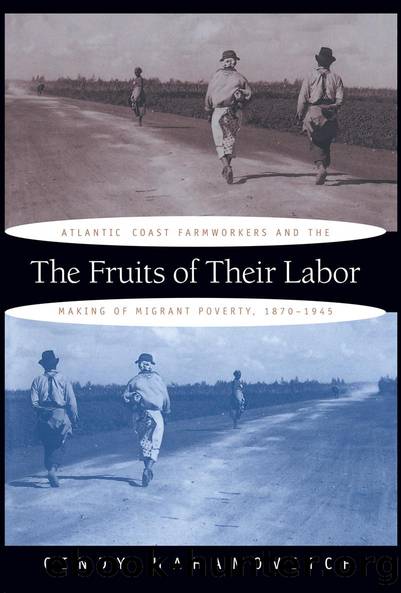The Fruits of Their Labor by Cindy Hahamovitch

Author:Cindy Hahamovitch [Hahamovitch, Cindy]
Language: eng
Format: epub
Tags: Social Science, Poverty & Homelessness, History, United States, General
ISBN: 9780807899922
Google: _WL0AwAAQBAJ
Publisher: Univ of North Carolina Press
Published: 2010-06-23T02:42:08+00:00
7: Uncle Sam as Padrone
The Politics of Labor Supply in Depression and War
The Wagner Act, which was signed into law in July 1935, excluded field workers and domesticsâsome 65 percent of African American workersâfrom its provisions.1 Still, field workers were not abandoned by the state. If New Dealers were unwilling to redress farmworkersâ power-lessness, they were gearing up to do something about their poverty. The agency that would take up their cause was the Resettlement Administration and its successor, the Farm Security Administration (FSA). The FSAâs mission was to serve the nationâs poorest rural people, including those excluded from or further impoverished by the administrationâs recovery measures. The FSA took 1 o million acres of marginal land out of production and resettÃed the families that had worked them. It created suburban âgreenbeltâ developments that were designed to increase rural income by combining cooperative farming and small industry. In one year alone it lent tenant farmers $260 million in low-interest loans to enable them to buy farms and gave out over $800 million in rehabilitation loans to prevent failing farmers from joining the ranks of the migrant poor. For those who had already gone bust and hit the road, the FSA began in 1935 to build migratory camps that would house and feed farmworkers in truck farming regions on both coasts.
Yet farmworkers enjoyed the guardianship of the FSA only temporarily. It was not long before the agency succumbed to the attacks of its congressional enemies. It was, in fact, the first casualty of the growing tide of anti-New Deal conservatism unleashed by the Second World War. As the âeconomy blocâ in Congress hammered on the need for cutbacks in nondefense spending and demanded the elimination of New Deal âexperimentation,â FSA advocates argued for the agencyâs preservation on the grounds of the Migratory Camp Programâs contribution to the war effort. In a sense this argument worked too well. By the spring of 1942 the FSAâs resettlement projects, cooperatives, land purchase, and small loan programs had all succumbed to the budgetary axe; the migrant camp program was the only FSA project left intact.2
With the nemesis agency out of the way, the U.S. Department of Agriculture (USDA) might simply have disbanded the Migratory Camp Program, but it did not. The camp program survived not only intact but vastly expanded. New camps drew migrants to areas where farmers would not or could not house them, and a transportation program helped move migrants immobilized by gas and tire shortages. Instead of serving the needs of Americaâs migrant poor, the camp program retooled to serve the needs of the nationâs labor poor.
Yet even though growers benefited from the services of the FSAâs labor supply program, they complained of labor shortages. Farmworkers had not vanished; they were using the security afforded by the federal migrant camps to wage informal but effective strikes. Though they proclaimed neutrality, FSA officials found themselves in the middle of a bitter struggle between farmworkers and truck farmers, and in the end they would be caught in the cross fire.
Download
This site does not store any files on its server. We only index and link to content provided by other sites. Please contact the content providers to delete copyright contents if any and email us, we'll remove relevant links or contents immediately.
Cecilia; Or, Memoirs of an Heiress — Volume 1 by Fanny Burney(32064)
Cecilia; Or, Memoirs of an Heiress — Volume 3 by Fanny Burney(31459)
Cecilia; Or, Memoirs of an Heiress — Volume 2 by Fanny Burney(31409)
The Great Music City by Andrea Baker(30784)
We're Going to Need More Wine by Gabrielle Union(18636)
All the Missing Girls by Megan Miranda(14748)
Pimp by Iceberg Slim(13781)
Bombshells: Glamour Girls of a Lifetime by Sullivan Steve(13689)
Fifty Shades Freed by E L James(12918)
Talking to Strangers by Malcolm Gladwell(12881)
Norse Mythology by Gaiman Neil(12836)
For the Love of Europe by Rick Steves(11528)
Crazy Rich Asians by Kevin Kwan(8891)
Mindhunter: Inside the FBI's Elite Serial Crime Unit by John E. Douglas & Mark Olshaker(8707)
The Lost Art of Listening by Michael P. Nichols(7165)
Enlightenment Now: The Case for Reason, Science, Humanism, and Progress by Steven Pinker(6877)
The Four Agreements by Don Miguel Ruiz(6322)
Bad Blood by John Carreyrou(6280)
Weapons of Math Destruction by Cathy O'Neil(5837)
